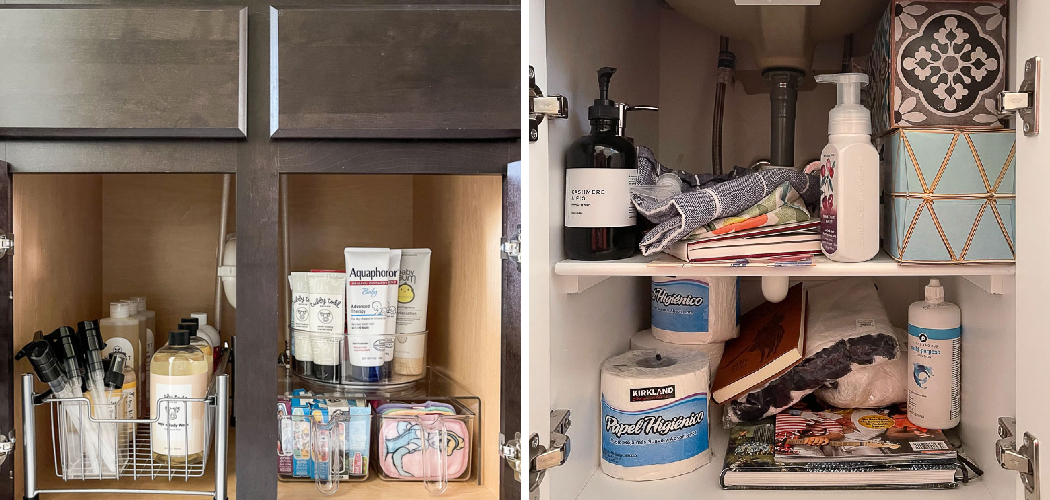Do you want to avoid opening your bathroom cabinets and finding everything in chaos? Do bottles, jars, and other toiletries come tumbling out whenever you try to grab something? Keeping a tidy bathroom can be challenging, mainly when you need more storage space.
How to organize bathroom cabinets without drawers can be a daunting task, but with a little creativity and strategic planning, you can maximize your space efficiently. Unlike cabinets with drawers, you’ll need to find alternative methods to store and separate your items, ensuring everything remains accessible and neat. In this guide, we’ll explore practical tips and clever solutions to help you maintain order in your bathroom cabinets, making your daily routines smoother and more enjoyable.
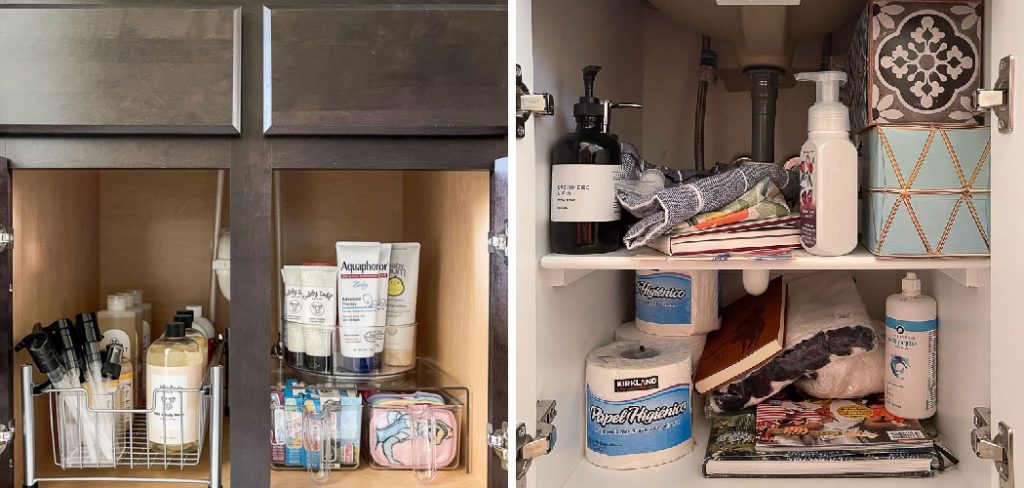
Whether dealing with limited space or just looking to improve your organization, these strategies will transform your storage game.
What Will You Need?
Before getting started, gather the necessary materials to help you stay organized. Here’s a list of some essential items that will come in handy:
- Baskets and Bins: These are excellent containers for grouping similar items like skincare products or hair accessories.
- Clear Containers: Transparent jars and boxes make it easier to see what’s inside and keep things visually appealing.
- Shelf Dividers: These can help create separate sections within your cabinets, making it easier to stack your belongings vertically.
- Labels: Whether you use a label maker or write by hand, labeling your containers can prevent confusion and save time when looking for specific items.
10 Easy Steps on How to Organize Bathroom Cabinets Without Drawers
Step 1: Declutter Your Cabinets
The first step to achieving an organized bathroom cabinet is decluttering. Start by emptying all the contents of your cabinets. This process helps you see everything you have and assess what needs to be kept or discarded. Examine each item closely and ask yourself whether it is expired, redundant, or if it serves a specific purpose in your daily routine. Over time, toiletries and beauty products can accumulate, creating unnecessary clutter that makes it difficult to maintain an orderly space. Disposing old or unused items will free up valuable space and make it easier to organize the essentials.
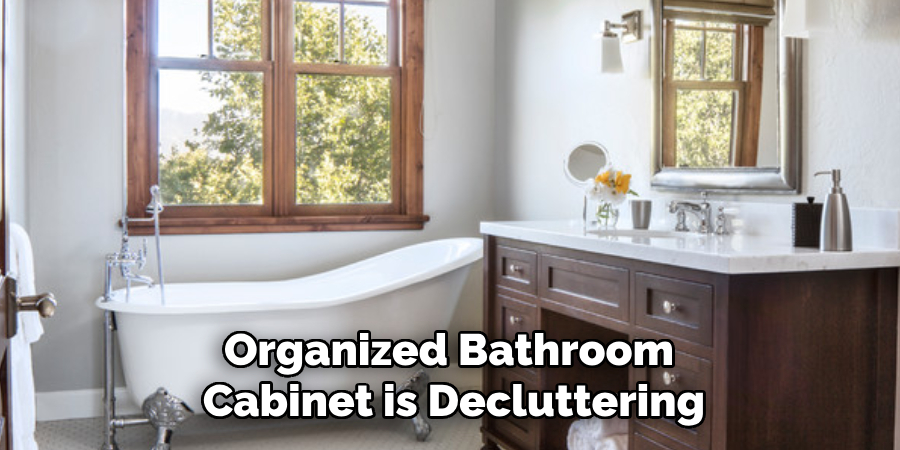
Next, categorize your remaining items into skincare, hair care, oral hygiene, and first aid groups. This step is crucial as it forms the basis for how you will organize your items within the cabinets. Grouping similar items will streamline your storage process, allowing you to find what you need quickly and easily. It also prevents mixing incompatible products, which can lead to spills and further disorganization. Dedicating specific sections of your cabinets to each category will create a more functional and efficient storage solution.
Step 2: Clean the Cabinet Interiors
Once you’ve decluttered, the next step is to clean your cabinets thoroughly. Use a gentle cleaning solution and a soft cloth to wipe down all surfaces inside the cabinets. Pay attention to corners and any built-up grime or residue. Cleaning the interiors ensures that your items are placed hygienically, preventing dust and dirt from settling on your toiletries and skincare products. This step also allows you to spot potential issues such as leaks or mold, which can be addressed before continuing with the organization process.
Step 3: Measure Your Cabinet Space
Before buying organizational tools like bins and baskets, take accurate measurements of your cabinet space. Use a tape measure to determine each cabinet shelf’s height, width, and depth. Having these dimensions on hand will guide you in selecting the right-sized containers that fit neatly within your space. Properly measured storage solutions will maximize every inch of your cabinet, ensuring a snug fit and preventing wasted space.
Step 4: Install Shelf Dividers
Consider installing shelf dividers to create distinct sections within your cabinets. These dividers can help keep your grouped items separate and easily accessible. Whether adjustable or fixed, shelf dividers allow you to stack items vertically without the risk of them toppling over. This is particularly useful for narrow cabinets where horizontal space is limited. Dividing your shelves into smaller compartments can also maintain a clearer, more organized structure.
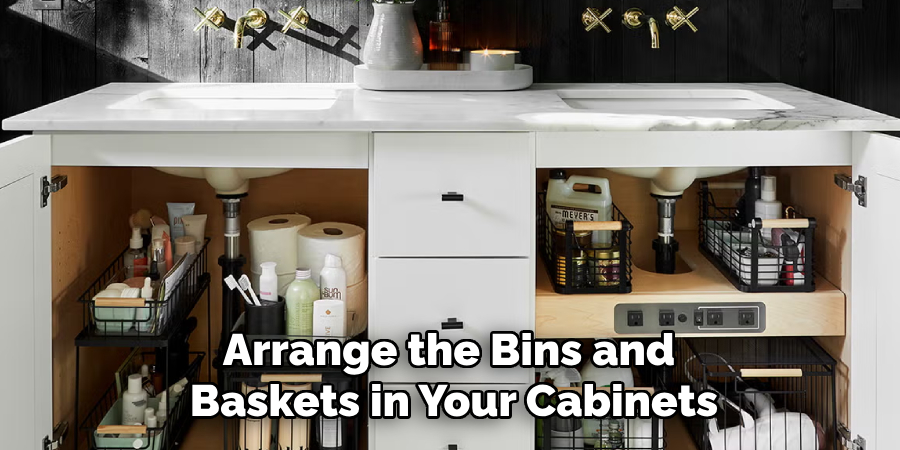
Step 5: Utilize Bins and Baskets
Start placing your categorized items into bins and baskets. Opt for clear containers to easily see what’s inside without rummaging through them. Group similar items together within each bin—for example, keep all your hair care products in one basket and skin care products in another. Using uniform containers also creates a cohesive look and helps maintain order. Arrange the bins and baskets in your cabinets according to frequency of use, with everyday items placed towards the front for easy access.
Step 6: Stackable Storage Solutions
Consider using stackable bins or container sets to maximize your vertical space if you have tall cabinets. These can be useful for storing smaller items like cotton swabs, makeup sponges, or travel-sized toiletries. Stackable solutions enable you to keep counters and shelves clear of clutter while ensuring everything has its designated place. This not only saves space but also adds a level of convenience as each item remains within reach.
Step 7: Add Lazy Susans for Easy Access
Incorporating lazy Susans can be a game changer for deeper cabinets where items tend to get lost at the back. These rotating trays allow you to spin the contents around, making it easy to find and reach items without sifting through everything. Lazy Susans are particularly effective for items that are used less frequently yet still need to be accessible when needed.
Step 8: Incorporate Hooks or Adhesive Holders
Maximize the unused vertical space inside cabinet doors by adding hooks or adhesive holders. These can be used to hang items like hair dryers, brushes, or even small baskets. Adhesive hooks and holders are easy to install. They can be repositioned as necessary, providing a flexible solution for storing awkwardly shaped or bulky items that are difficult to place on shelves.
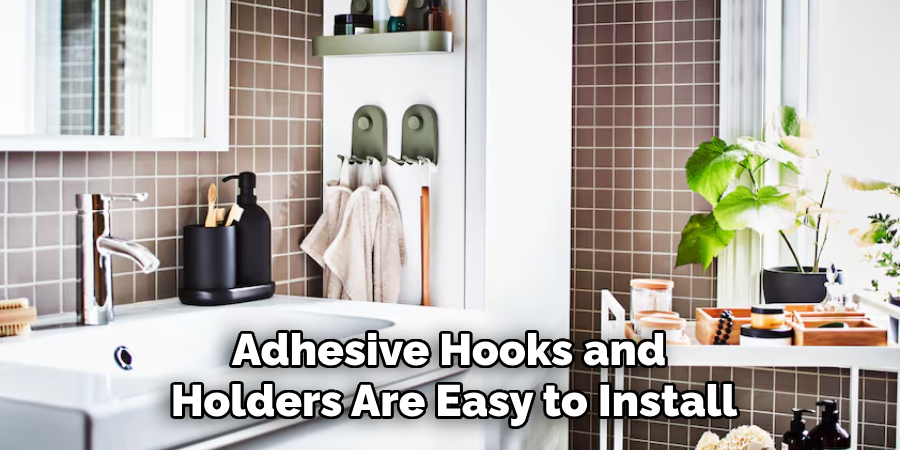
Step 9: Label Everything
Labeling your containers and bins is a simple yet effective way to maintain order in your bathroom cabinets. Whether you use a label maker or handwritten labels, this step will help you quickly identify where each item belongs, making it easier to maintain your organizational system. Labels can also be helpful for family members, ensuring everyone knows where to return items after use.
Step 10: Regularly Reevaluate and Adjust
Keeping your bathroom cabinets organized is an ongoing process. Regularly reevaluate your storage system and make adjustments as needed. Discard expired products and move items around based on changing needs or usage patterns. By periodically reassessing your organization, you can ensure that your storage solutions continue to serve you well over time, keeping your bathroom tidy and functional.
Following these steps, you can transform your cluttered bathroom cabinets into an organized and functional space.
5 Additional Tips and Tricks
- Use Clear Bins and Containers: Opt for clear storage bins to keep items organized and easily visible. This method helps you quickly identify what’s inside without rummaging through everything.
- Incorporate Shelf Risers: Adding shelf risers can double your cabinet space by creating additional layers. This is especially useful for small items like skincare products and medicines.
- Utilize Door Space with Hooks and Racks: Attach hooks or over-the-door racks inside cabinet doors to hang hair tools, brushes, or cleaning supplies. This makes good use of otherwise wasted space.
- Add Stackable Drawers: Even though the cabinet itself doesn’t have drawers, you can purchase small stackable drawer units. These can fit inside your cabinets and provide segmented storage for smaller items such as makeup or toiletries.
- Keep Frequently Used Items at Eye-Level: To save time and effort, keep your most frequently used items at eye-level in your cabinets. This makes them easily accessible without reaching or digging through other items.
These additional tips and tricks can help further streamline and improve the organization of your kitchen cabinets.
5 Things You Should Avoid
- Overcrowding the Space: Avoid cramming too many items into your cabinets. Overcrowding makes it challenging to find what you need and can create a cluttered appearance. Instead, prioritize and limit the number of items stored in each cabinet.
- Ignoring Vertical Space: Not utilizing the full height of your cabinets is a common mistake. To maximize space, avoid leaving the top sections empty and consider incorporating vertical dividers, stackable organizers, or tiered shelves.
- Mixing Unrelated Items: Mixing toiletries with cleaning supplies or other unrelated items can make it harder to locate specific products when needed. Keep similar items grouped together to maintain a more functional and organized space.
- Neglecting to Label: Without drawer dividers, smaller items can get lost or misplaced. Avoid confusion by labeling bins, containers, or shelves to indicate the contents clearly. This helps maintain order and ensures everything has a designated spot.
- Using Inefficient Containers: Steer clear of using containers that don’t fit well within your cabinet space. Bulky or oddly shaped containers can waste valuable space. Opt for streamlined, stackable, uniform containers to maximize your cabinet’s storage potential.
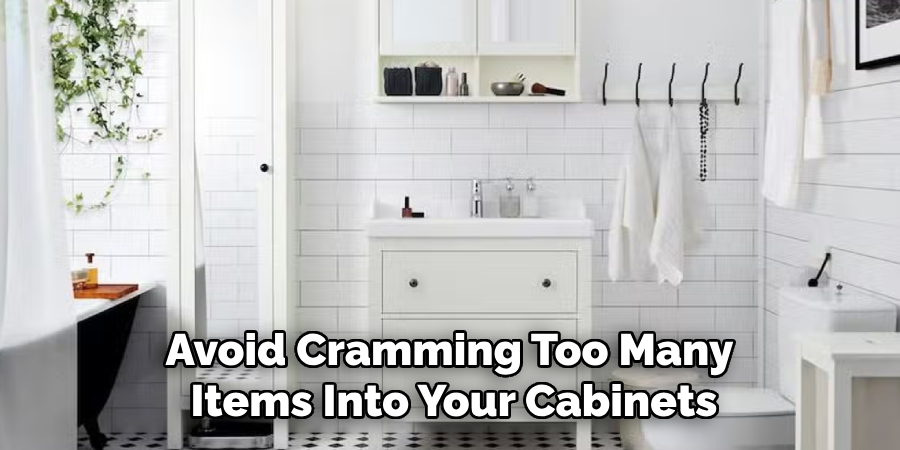
Avoiding these common pitfalls will help you maintain a more organized and functional bathroom cabinet space.
Conclusion
How to organize bathroom cabinets without drawers is achievable by strategically implementing a few key practices. Begin by utilizing clear bins and stackable organizers to keep items easily visible and accessible.
Make efficient use of vertical space with shelf risers and vertical dividers, ensuring no wasted area. Incorporate hooks and racks inside cabinet doors to hang essentials, and always keep frequently used items within easy reach. Avoid common pitfalls such as overcrowding, ignoring vertical space, and using inefficient containers.
By following these tips and staying mindful of organization, your bathroom cabinet will remain tidy and functional, making your daily routine smoother and more enjoyable.

